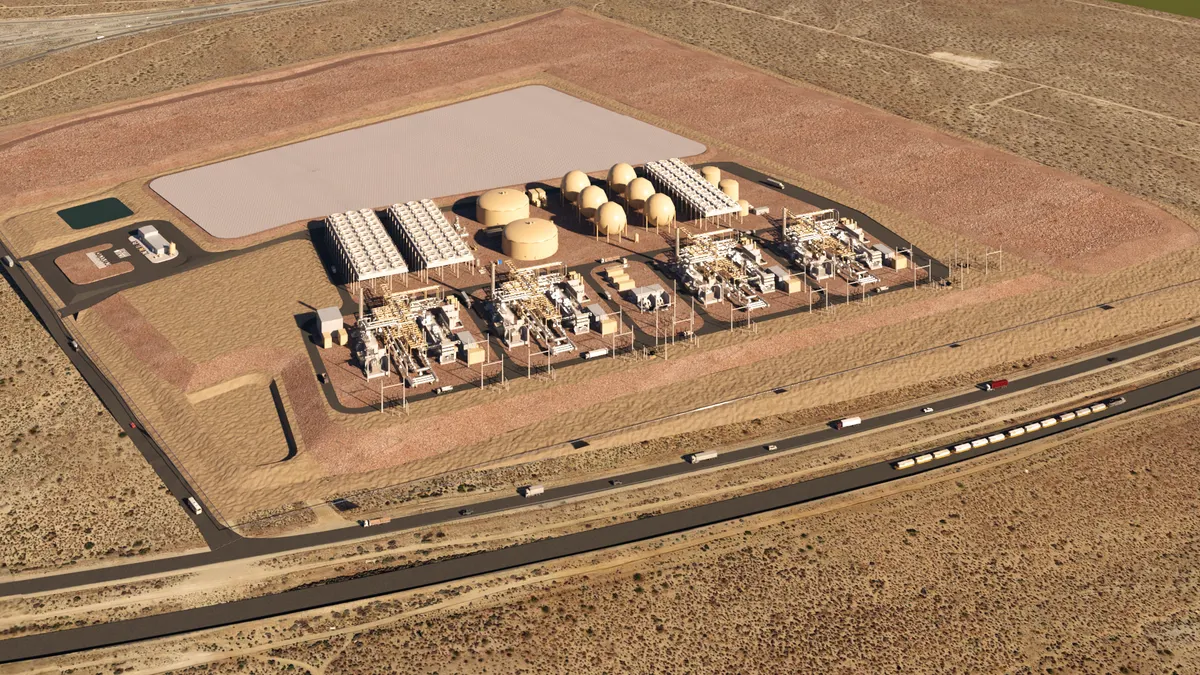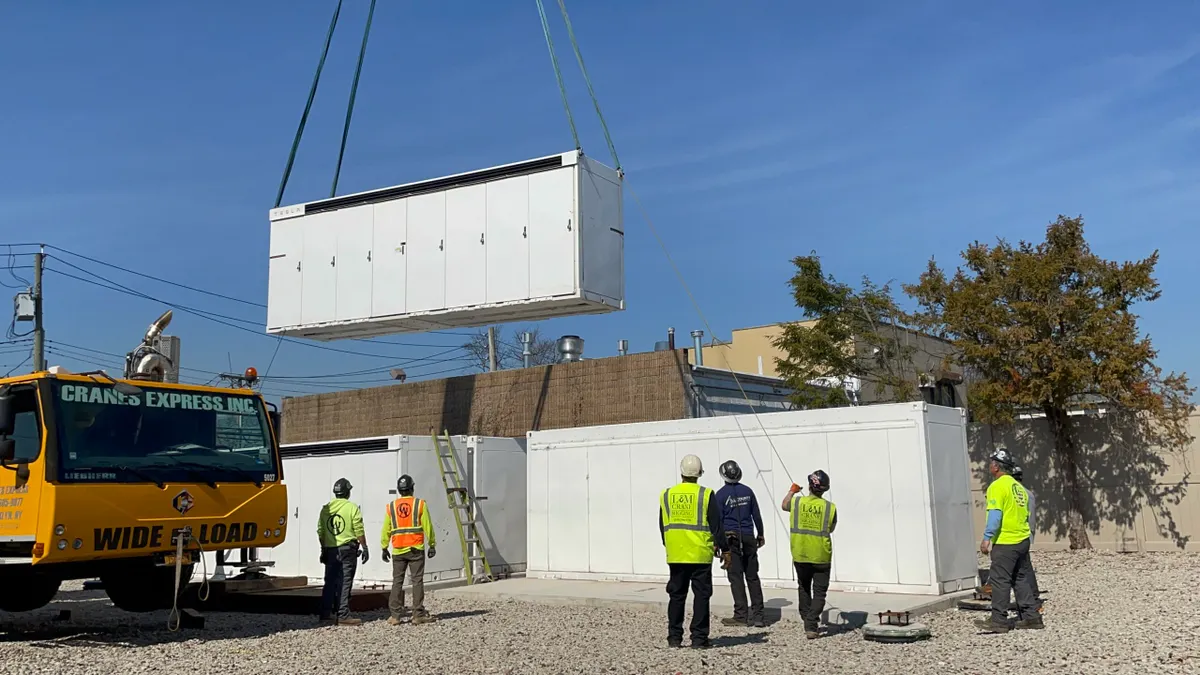Falling battery costs, increasing renewables on the grid and a focus on resilience and reliability will continue to drive growth in the energy storage sector in 2020.
Storage has had a good year, experts say: multiple states have made storage deployment a priority, utilities began rolling out pilot programs and battery prices continued to plunge. The average cost of battery packs dipped to $156/kWh in 2019 — 87% lower than 2010 prices — and are predicted to drop to $100/kWh by 2023. And the sector is projected to continue growing in 2020 and beyond. In December, analysts at Wood Mackenzie predicted the storage market will expand over 700% in the next half decade, driven in part by the need for grid resiliency and reliability.
At the same time, storage developers will face a lot of challenges going into 2020, including increasing safety regulations and market uncertainty caused in part by the U.S. House of Representatives rejection in December of a tax credit for standalone storage systems.
There are three key trends in the storage market right now, according to Kelly Speakes-Backman, CEO at the Energy Storage Association (ESA) — "the economic outlook for storage, which has been really positive; state activity that's been happening in terms of both policies and planning; and third, I'll mention the recognition of energy storage as the central hub of the modern energy ecosystem," she told Utility Dive.
Going into 2020, the focus will remain on giving storage systems an equal playing field as other clean energy technologies, she said, including a push to pass legislation incentivizing stand-alone energy storage.
Resource retirements and shut-offs will boost storage deployments
Utilities, particularly in western states, will look to storage to replace resources like coal generation and peaking units scheduled for retirement, Judy Chang, principal at the Brattle Group, told Utility Dive.
More and more vertically-integrated utilities anticipate retirements in the coming years, and some will turn to solar coupled with storage — with solar providing the energy and storage providing the peaking capability and resource adequacy capacity, she said.
"If transmission costs continue to increase and distribution companies can make investments on the distribution system... I think they're going to deploy storage to avoid transmission charges."

Judy Chang
Principal, Brattle Group
"I think going into 2020 we're going to see more of those projects being announced," Chang said.
She is also keeping an eye on the use of storage deployment as a transmission tool, which could grow the sector in the future. And some utilities with transmission assets are also likely to deploy storage instead of traditional transmission upgrades to solve reliability issues.
"If transmission costs continue to increase and distribution companies can make investments on the distribution system... I think they're going to deploy storage to avoid transmission charges," she said.
In California, behind-the-meter storage adoption will largely be driven by wildfire-related public safety power shut-offs, Alex Morris, executive director of the California Energy Storage Alliance (CESA), told Utility Dive. The state is already making moves in that direction — in December, the California Public Utilities Commission proposed to expand its self-generation incentive program to help customers who live in high fire-threat areas install storage as a resilience measure.
Pacific Gas & Electric's safety power shut-offs — as well as blackouts in New York and London — have highlighted the need for storage resources that can bolster communities and businesses, Wendy Prabhu, co-founder of the Mercom Capital Group, a clean tech research and communication firm, told Utility Dive.
"[The black-outs] have really driven the need for really large-scale, longer-duration storage technologies that can truly support the grid and help with grid stability," she said.
California's storage industry will also grow as utility rates and customer choice preferences evolve, Morris said. In areas where rates are especially high, solar coupled with storage can be a more cost-effective option for consumers — for instance in San Diego, where CESA has seen a huge boom in residential storage deployments.
"Residential customers are clearly indicating that they want to use storage to maintain their electric system and needs," Morris said.
In December, regulators approved 590 MW of storage capacity as part of NV Energy's integrated resource plan. In Arizona, two solar and storage projects are projected to achieve 60% of the state's goal to have 1 GW of renewable energy by 2025. And in Massachusetts, National Grid has installed a 6 MW, 48 MWh storage system to address reliability issues in Nantucket Island.
State policies on storage deployment will contribute to market growth in 2020, much like they did in 2019, Speakes-Backman said. Utilities in states with Renewable Portfolio Standard goals are using storage resources to combat the intermittency of solar and wind resources, "injecting clean energy into the grid when the sun isn't shining."
Thirty-two states currently include storage in their planning requirement and more than 20 states have passed some type of legislation providing incentives, target or planning rules for storage, according to Speakes-Backman. Storage deployments in states are driven by both utilities and individual customers, Prabhu said. Utilities are likely to ramp up storage resources to address resilience issues, whereas some markets will turn to it from an economic perspective — like in California, where businesses need to plan for future black-outs.
On a national level, another development Speakes-Backman will keep her eye on is filings under the Federal Energy Regulatory Commission's Order 841 — a 2018 order that required regional transmission organizations and independent system operators to create rules for storage to participate in wholesale energy markets.
"In 2020, I think we're going to see more of the RTOs and ISOs submitting their plans for FERC 841, so I think that's going to be interesting," she said.
Part of the reason experts predict growth in the storage sector is the continuing decrease in battery costs. The overall installation cost of lithium-ion batteries has dropped by around 70% to 80% in the last eight years, according to Speakes-Backman, and she forecasts that they will continue to drop by 10% to 15% annually in 2020 through 2024.
"I believe prices will continue to fall and I think that's going to be a continued driver going forward, very much like the solar market," Prabhu said.
ITC, tariffs and other obstacles facing the storage sector
But the storage industry will also have to confront regulatory and other challenges going into 2020, experts think — especially after the House of Representatives' omission of an investment tax credit (ITC) for standalone energy storage, a move that Speakes-Backman called "disappointing" in a press release.
"One of the big challenges that we're facing is making sure that energy storage is accounted for on a level playing field as the other clean technologies, and that's quite simply getting it included in the ITC," she said.
A standalone storage tax credit would also reduce the uncertainty introduced by a 15% tariff on lithium-ion batteries and associated equipment from Chinese imports, she said — another challenge the industry needs to face down, in her mind. Storage companies will need to convince the Trump administration that while they agree that the United States should have leadership in the industry, "we don't think that tariffs and tariffs alone are the way to do it," she said.
Another obstacle facing storage developers will be regulatory barriers that prevent utilities from making storage investments, according to Chang — for instance in Texas, where transmission and distribution utilities cannot own battery storage.
"One of the things we're seeing more now is the advent of tougher safety regulations around energy storage that's making it more difficult to deploy," Roger Lin, vice president of marketing at NEC Energy Solutions, told Utility Dive. This is especially the case for systems near populated areas. Regulations for deploying large-scale storage systems around New York City "are probably the toughest in the world that I've seen," he said.
Concerns over the safety of large-scale battery facilities arose especially after the explosion at Arizona Public Service's McMicken storage facility last April, which injured four firefighters. But the industry is moving quickly to address safety issues. In September, the National Fire Protection Association issued a new standard that is the first set of guidelines addressing fire risk and other safety issues connected to battery systems. The standard includes specifications on the ventilation, signage and emergency operations related to battery systems, based on their technology, location and size.
"There's things in motion to make the entire industry safer," Lin said.
What else does 2020 hold for storage?
"I'd definitely keep an eye on how storage on the distribution system can participate in wholesale markets — the whole coordination issue between wholesale and distribution, or bulk system versus distribution system, I think that's something to watch out for," Chang said.
Morris, meanwhile, plans to pay attention to the growing interest in long-duration storage, especially in California.
"I'll keep my eyes on how storage is chosen in long-term planning models, which seem to indicate there may be 11,000 MW needed by 2030 in California alone. And I'll look at how storage is valued for planning capacity, whether that's when it's in hybridized forms, as with solar, or on a stand-alone basis," he said.























